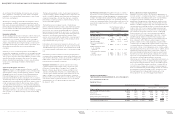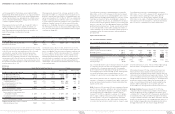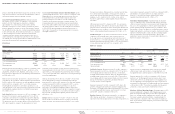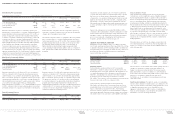Equifax 2013 Annual Report Download - page 16
Download and view the complete annual report
Please find page 16 of the 2013 Equifax annual report below. You can navigate through the pages in the report by either clicking on the pages listed below, or by using the keyword search tool below to find specific information within the annual report.
27 EQUIFAX 2013 ANNUAL REPORT
likely than not of being sustained under such examinations. We
assess the potential outcome of such examinations to determine the
adequacy of our income tax accruals.
Judgments and uncertainties — We consider accounting for income
taxes critical because management is required to make significant
judgments in determining our provision for income taxes, our deferred
tax assets and liabilities, and our future taxable income for purposes
of assessing our ability to realize any future benefit from our deferred
tax assets. These judgments and estimates are affected by our
expectations of future taxable income, mix of earnings among differ-
ent taxing jurisdictions, and timing of the reversal of deferred tax
assets and liabilities.
We also use our judgment to determine whether it is more likely than
not that we will sustain positions that we have taken on tax returns
and, if so, the amount of benefit to initially recognize within our
financial statements. We review our uncertain tax positions and adjust
our unrecognized tax benefits in light of changes in facts and
circumstances, such as changes in tax law, interactions with taxing
authorities and developments in case law. These adjustments to our
unrecognized tax benefits may affect our income tax expense. Settle-
ment of uncertain tax positions may require use of our cash. At
December 31, 2013, $22.6 million was recorded for uncertain tax
benefits, including interest and penalties, of which it is reasonably
possible that up to $6.0 million of our unrecognized tax benefit may
change within the next twelve months.
Effect if actual results differ from assumptions — Although manage-
ment believes that the judgments and estimates discussed herein are
reasonable, actual results could differ, and we may be exposed to
increases or decreases in income tax expense that could be material.
Pension and Other Postretirement Plans
We consider accounting for our U.S. and Canadian pension and
other postretirement plans critical because management is required
to make significant subjective judgments about a number of actuarial
assumptions, which include discount rates, expected return on plan
assets, interest cost and mortality and retirement rates. Actuarial
valuations are used in determining our benefit obligation and net
periodic benefit cost.
Judgments and uncertainties — We believe that the most significant
assumptions related to our net periodic benefit cost are (1) the
discount rate and (2) the expected return on plan assets, in each case
as it relates to our U.S. pension plan. Our Canadian plan is small, and
the impact of changes in assumptions for that plan is not material.
We determine our discount rates primarily based on high-quality,
fixed-income investments and yield-to-maturity analysis specific to
our estimated future benefit payments available as of the measure-
ment date. Discount rates are updated annually on the measurement
date to reflect current market conditions. We use a third party yield
curve to develop our discount rates. The yield curve provides
discount rates related to a dedicated high-quality bond portfolio
whose cash flows extend beyond the current period, from which we
choose a rate matched to the expected benefit payments required for
each plan.
The expected rate of return on plan assets is based on both our
historical returns and forecasted future investment returns by asset
class, as provided by our external investment advisor. In 2013, the
U.S. pension plan investment returns of 11.4% exceeded the
expected return of 7.5% for the fourth time in the last five years. The
expected return for 2014 remains at 7.5%, which is consistent with
the rate used for 2013. The CRIP earned 13.5% in 2013 also
exceeding its expected return of 6.75% for the fourth time in five
years. The CRIP has a lower expected return due to a higher asset
allocation to fixed income securities. Our weighted-average expected
rate of return for both plans for 2014 is 7.43% which was also the
2013 expected rate.
Annual differences, if any, between the expected and actual returns on
plan assets are included in unrecognized net actuarial gain or loss, a
component of other comprehensive income. In calculating the annual
amortization of the unrecognized net actuarial gain or loss, we use a
market-related value of assets that smoothes actual investment gains
and losses on plan assets over a period up to five years. The resulting
unrecognized net actuarial gain or loss amount is recognized in net
periodic pension expense over the average remaining life expectancy
of the participant group since almost all participants are inactive. The
market-related value of our assets was $554.8 million at December 31,
2013. We do not expect our 2014 net periodic benefit cost, which
includes the effect of the market-related value of assets, to be materi-
ally different than our 2013 cost. See Note 11 of the Notes to the
Consolidated Financial Statements for details on changes in the pen-
sion benefit obligation and the fair value of plan assets.
Effect if actual results differ from assumptions — We do not believe
there is a reasonable likelihood that there will be a material change in
the future estimates or assumptions that are used in our actuarial
valuations. Adjusting our weighted-average expected long-term rate
of return (7.43% at December 31, 2013) by 50 basis points would
change our estimated pension expense in 2014 by approximately
$2.8 million. Adjusting our weighted-average discount rate (5.07% at
December 31, 2013) by 50 basis points would change our estimated
pension expense in 2014 by approximately $0.8 million. However, if
actual results are not consistent with our estimates or assumptions,
we may be exposed to changes in pension expense that could be
material.
Purchase Accounting for Acquisitions
We account for acquisitions under Accounting Standards Codification
805, Business Combinations, which changed the application of the
acquisition method of accounting in a business combination and also
modified the way assets acquired and liabilities assumed are
MANAGEMENT’S DISCUSSION AND ANALYSIS OF FINANCIAL CONDITION AND RESULTS OF OPERATIONS continued
28 EQUIFAX 2013 ANNUAL REPORT
recognized on a prospective basis. In general, the acquisition method
of accounting requires companies to record assets acquired and
liabilities assumed at their respective fair market values at the date of
acquisition. We primarily estimate fair value of identified intangible
assets using discounted cash flow analyses based on market
participant based inputs. Any amount of the purchase price paid that is
in excess of the estimated fair values of net assets acquired is
recorded in the line item goodwill in our consolidated balance sheets.
Transaction costs, as well as costs to reorganize acquired companies,
are expensed as incurred in our Consolidated Statements of Income.
Judgments and uncertainties — We consider accounting for business
combinations critical because management’s judgment is used to
determine the estimated fair values assigned to assets acquired and
liabilities assumed and amortization periods for intangible assets,
which can materially affect the our results of operations.
Effect if actual results differ from assumptions — Although manage-
ment believes that the judgments and estimates discussed herein are
reasonable, actual results could differ, and we may be exposed to an
impairment charge if we are unable to recover the value of the
recorded net assets.
QUANTITATIVE AND QUALITATIVE DISCLOSURES ABOUT
MARKET RISK
In the normal course of our business, we are exposed to market risk,
primarily from changes in foreign currency exchange rates and inter-
est rates that could impact our results of operations and financial
position. We manage our exposure to these market risks through our
regular operating and financing activities, and, when deemed
appropriate, through the use of derivative financial instruments, such
as interest rate swaps, to hedge certain of these exposures. We use
derivative financial instruments as risk management tools and not for
speculative or trading purposes.
Foreign Currency Exchange Rate Risk
A substantial majority of our revenue, expense and capital
expenditure activities are transacted in U.S. dollars. However, we do
transact business in other currencies, primarily the British pound, the
Canadian dollar, the Chilean peso, the Argentine peso and the Euro.
For most of these foreign currencies, we are a net recipient, and,
therefore, benefit from a weaker U.S. dollar and are adversely
affected by a stronger U.S. dollar relative to the foreign currencies in
which we transact significant amounts of business.
We are required to translate, or express in U.S. dollars, the assets and
liabilities of our foreign subsidiaries that are denominated or measured
in foreign currencies at the applicable year-end rate of exchange on
our Consolidated Balance Sheets and income statement items of our
foreign subsidiaries at the average rates prevailing during the year. We
record the resulting translation adjustment, and gains and losses
resulting from the translation of intercompany balances of a long-term
investment nature within other comprehensive income, as a
component of our shareholders’ equity. Foreign currency transaction
gains and losses, which have historically been immaterial, are recorded
on our Consolidated Statements of Income. We generally do not
mitigate the risks associated with fluctuating exchange rates, although
we may from time to time through forward contracts or other derivative
instruments hedge a portion of our translational foreign currency
exposure or exchange rate risks associated with material transactions
which are denominated in a foreign currency.
For the year ended December 31, 2013, a 10% weaker U.S. dollar
against the currencies of all foreign countries in which we had opera-
tions during 2013 would have increased our revenue by $52.0 million
and our pre-tax operating profit by $17.4 million. For the year ended
December 31, 2012, a 10% weaker U.S. dollar against the currencies
of all foreign countries in which we had operations during 2012 would
have increased our revenue by $49.4 million and our pre-tax operat-
ing profit by $16.7 million. A 10% stronger U.S. dollar would have
resulted in similar decreases to our revenue and pre-tax operating
profit for 2013 and 2012.
On average across our mix of international businesses, foreign cur-
rencies at December 31, 2013, were weaker against the U.S. dollar
than the average foreign exchange rates that prevailed across the full
year 2013. As a result, if foreign exchange rates were unchanged
throughout 2014, foreign exchange translation would reduce growth
as reported in U.S. dollars. As foreign exchange rates change daily,
there can be no assurance that foreign exchange rates will remain
constant throughout 2014, and rates could go either higher or lower.
Interest Rate Risk
Our exposure to market risk for changes in interest rates relates to
our variable-rate, long-term Senior Credit Facility and commercial
paper borrowings, as well as our interest rate swaps which economi-
cally convert our 2014 fixed rate bonds from a fixed rate of interest to
a floating rate. We attempt to achieve the lowest all-in weighted-aver-
age cost of debt while simultaneously taking into account the mix of
our fixed- and floating-rate debt, and the average life and scheduled
maturities of our debt. At December 31, 2013, our weighted average
cost of debt was 4.6% and weighted-average life of debt was
9.3 years. At December 31, 2013, 81% of our debt was fixed rate,
and the remaining 19% was variable rate after giving effect to the
interest rate swaps on our 2014 bonds. Occasionally we use deriva-
tives to manage our exposure to changes in interest rates by entering
into interest rate swaps. A 100 basis point increase in the weighted-
average interest rate on our variable-rate debt would have increased
our 2013 interest expense by $2.8 million.
Based on the amount of outstanding variable-rate debt, we have
exposure to interest rate risk. In the future, if our mix of fixed-rate and
variable-rate debt were to change due to additional borrowings under
existing or new variable-rate debt, we could have additional exposure
to interest rate risk. The nature and amount of our long-term and
short-term debt, as well as the proportionate amount of fixed-rate
and variable-rate debt, can be expected to vary as a result of future
business requirements, market conditions and other factors.
























